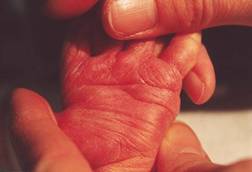Extremities
Each extremity should be carefully examined for polydactyly or syndactyly. Most babies have three palmar creases. A single palmar crease crossing the hand is present in about 4% of normal babies but may also be associated with chromosomal anomalies such as Down Syndrome.
|
Single Palmar Crease |
Bowing of the legs is a normal variation, as are positional abnormalities such as metatarsus adductus which result from intrauterine compression, but one should be able to place the extremity easily in the normal position. Inability to do so suggests pathology.
Hips
Developmental hip dysplasia (congenital dislocation) occurs in 1-3/1000 live births. It is more common in females by a 9:1 ratio, and is more common in children who have been in a breech position in utero. Suspicion of hip dysplasia requires immediate consultation with a pediatric orthopedic surgeon.
To check for this condition, the baby should be placed supine with the hips and knees flexed to 90°. The middle finger of each hand is placed over the greater trochanter of the tibia and the thumb on the opposite side of the hip joint, over the lesser trochanter. First a posterior pressure is applied; if the hip is dislocatable, it will snap out of the acetabulum with a click or a clunk. However, if the head of the femur is already dislocated, abducting the hips will be difficult or will result in a click as the head of the femur slips forward into the acetabulum. These maneuvers can best be performed on both hips simultaneously or while stabilizing the other hip with the opposite hand.





